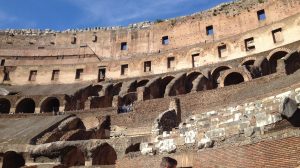My wife and I just returned from a trip to Italy with a new perspective on age. Not our age, but the age of things we’ve observed.
We’ve been to Philadelphia, Boston, and other colonial cities, and have seen houses that were built 250 years ago. We’ve been to England, where we once had lunch in a pub that had opened 650 years before. But those seem young compared to such Roman structures as The Colosseum and The Pantheon, built almost 2,000 years ago.
They and others are still standing, although only The Pantheon is still in good condition. Its dome (still the world’s largest un-reinforced concrete dome) remains a stunning architectural achievement, regardless of its era. Standing under it and looking up at the hole in the middle (“The Oculus”) with a shaft of sunlight pouring in was one of the highlights of our visit.
The Colosseum is, well, let’s call it a fixer-upper. There’s scaffolding down one side where restoration work is being done. But when you get inside and see the scale of the place, and stand where gladiators fought, it takes your breath away. If you go, we suggest the Dark Rome “underground” tour, with a guide who can put it all in context (rather than just wandering through the ruins yourself).
It’s a little odd to walk or drive through the city and see the ruins of ancient Rome on the other side of the sidewalk — and archaeologists are still finding remnants of that era. The city has been trying to build a third subway line, but every time they excavate for a station or new tracks, they have to halt construction because they’ve uncovered more artifacts from two millenia ago, buried by the layers of civilization since. It’s not as if the digging for history began this year — it’s been going on for decades, and they’re still discovering new items.
Our Rome trip wasn’t all about old buildings, of course. We also went for the good food, and found plenty of it, including the best spaghetti carbonara we’ve ever had. We were also introduced to “pizza a taglia,” which doesn’t come in slices or round pies, but is baked in long rectangles. When you go to the pizzeria, you tell the person behind the counter which flavor you want — topped by prosciutto, spinach, or just mozzarella and sauce — and they cut off as big a piece as you want, then charge you by its weight. It’s a good thing the airline didn’t charge us by our weight for the return flight.
One evening we took a food tour through the Trastevere neighborhood, which included stops at various restaurants and shops. We had fried artichoke at one place, then off to a wine cellar at another, then a cookie factory that’s been run by the same family for generations. Next we went to a shop that sells cheese and cured meat, run by Signore Roberto, where we tasted some fantastic Pecorino Romano (there were several 35kg wheels of it stacked up in the very busy shop). Signore Roberto is so beloved in the neighborhood, so the story goes, that when one thief attempted to steal from his store, another thief thwarted the first by telling him, “we don’t steal from Signore Roberto!”
Our next course was called “suppli” (rice, sauce, and mozzarella, in a fried dough ball) — followed by another place that made pizza a taglia. Next was a famous local restaurant that specializes in pasta, and for the finale, a genuine gelato place — just one of many we stopped at during our trip.
Okay, I’ll admit it. We didn’t let a day go by without gelato, pizza, and pasta. Why would we? You know the expression, “When in Rome, put on the pounds!”
In the next part of this road trip, we went to Florence to see The David, cross an old bridge, and eat wild boar. Read about it here.

